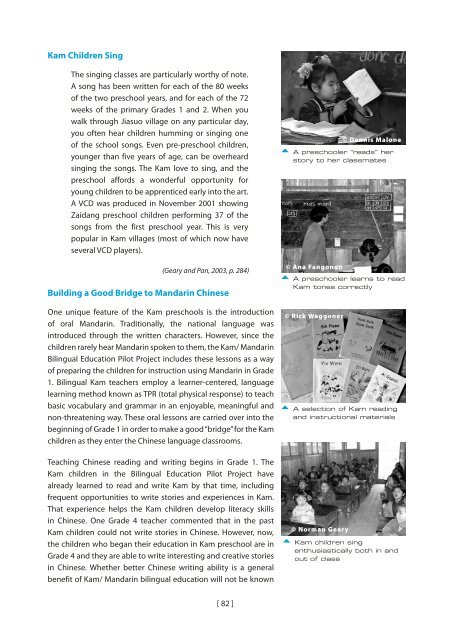Mother Tongue-based Literacy Programmes: Case Studies of Good ...
Mother Tongue-based Literacy Programmes: Case Studies of Good ...
Mother Tongue-based Literacy Programmes: Case Studies of Good ...
Create successful ePaper yourself
Turn your PDF publications into a flip-book with our unique Google optimized e-Paper software.
Kam Children SingThe singing classes are particularly worthy <strong>of</strong> note.A song has been written for each <strong>of</strong> the 80 weeks<strong>of</strong> the two preschool years, and for each <strong>of</strong> the 72weeks <strong>of</strong> the primary Grades 1 and 2. When youwalk through Jiasuo village on any particular day,you <strong>of</strong>ten hear children humming or singing one<strong>of</strong> the school songs. Even pre-preschool children,younger than five years <strong>of</strong> age, can be overheardsinging the songs. The Kam love to sing, and thepreschool affords a wonderful opportunity foryoung children to be apprenticed early into the art.A VCD was produced in November 2001 showingZaidang preschool children performing 37 <strong>of</strong> thesongs from the first preschool year. This is verypopular in Kam villages (most <strong>of</strong> which now haveseveral VCD players).(Geary and Pan, 2003, p. 284)Building a <strong>Good</strong> Bridge to Mandarin Chinese© Dennis Malone A preschooler “reads” herstory to her classmates© Ana Fangonon A preschooler learns to readKam tones correctlyOne unique feature <strong>of</strong> the Kam preschools is the introduction<strong>of</strong> oral Mandarin. Traditionally, the national language wasintroduced through the written characters. However, since thechildren rarely hear Mandarin spoken to them, the Kam/ MandarinBilingual Education Pilot Project includes these lessons as a way<strong>of</strong> preparing the children for instruction using Mandarin in Grade1. Bilingual Kam teachers employ a learner-centered, languagelearning method known as TPR (total physical response) to teachbasic vocabulary and grammar in an enjoyable, meaningful andnon-threatening way. These oral lessons are carried over into thebeginning <strong>of</strong> Grade 1 in order to make a good “bridge” for the Kamchildren as they enter the Chinese language classrooms.© Rick Waggoner A selection <strong>of</strong> Kam readingand instructional materialsTeaching Chinese reading and writing begins in Grade 1. TheKam children in the Bilingual Education Pilot Project havealready learned to read and write Kam by that time, includingfrequent opportunities to write stories and experiences in Kam.That experience helps the Kam children develop literacy skillsin Chinese. One Grade 4 teacher commented that in the pastKam children could not write stories in Chinese. However, now,the children who began their education in Kam preschool are inGrade 4 and they are able to write interesting and creative storiesin Chinese. Whether better Chinese writing ability is a generalbenefit <strong>of</strong> Kam/ Mandarin bilingual education will not be known© Norman Geary Kam children singenthusiastically both in andout <strong>of</strong> class[ 82 ]

















